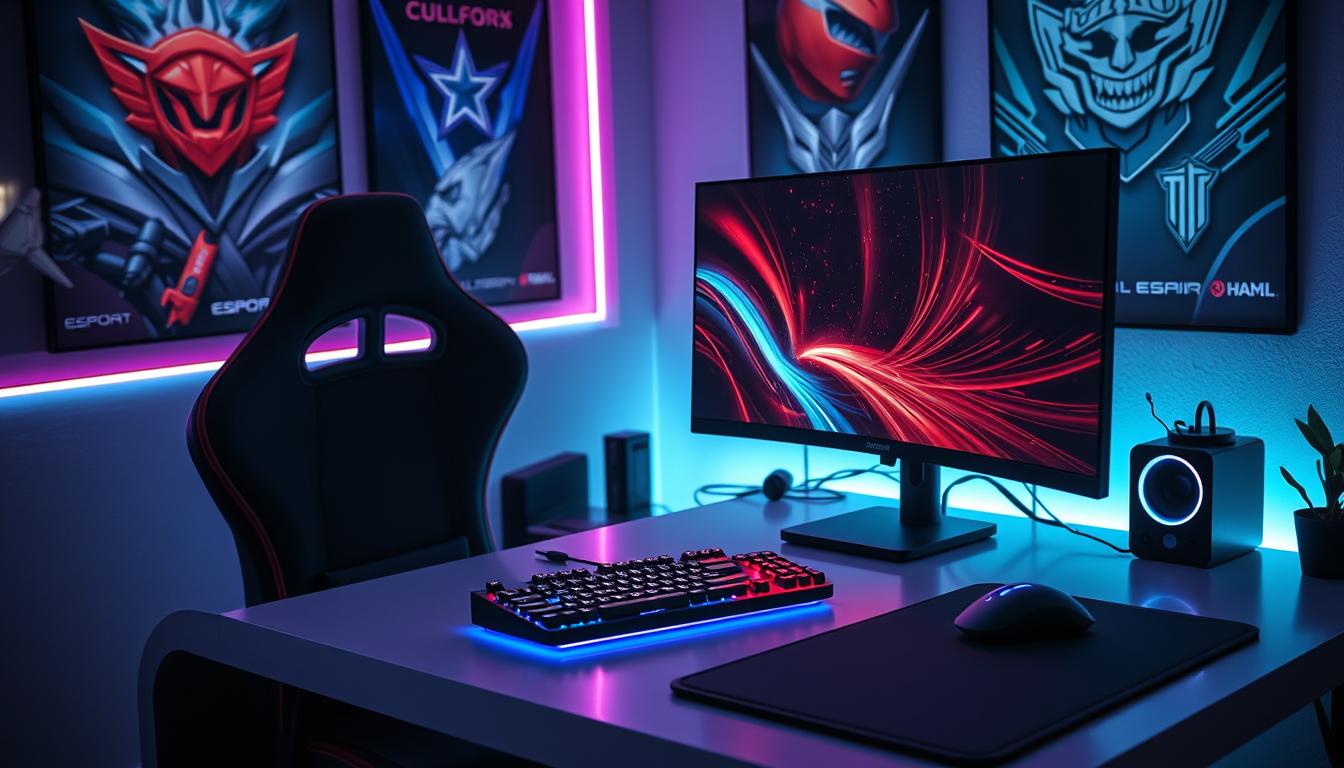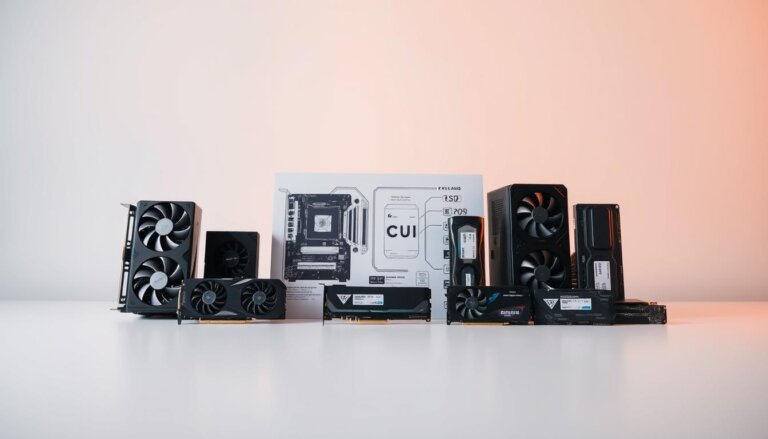Pro Gaming Settings Used by Top Players
Ever wondered what secret settings pro gamers use to dominate virtual worlds? The answer lies in their meticulous game environments. Top players fine-tune every aspect of their setting game to gain a competitive edge.
Pro gamers optimize their gameplay by adjusting resolution, display mode, and graphics quality. In popular tactical shooters, they often use low to medium settings to boost frame rates and reduce visual clutter. This approach creates cleaner game environments for better focus and reaction times.
Key settings for pro players include disabling V-Sync and setting Anti-Aliasing to MSAA x2. They also turn off features like Bloom and Distortion to minimize distractions in their virtual worlds. These tweaks help create a streamlined visual experience, allowing pros to spot enemies faster and aim more accurately.
Stats show that 76% of pro players use a DPI setting of 800 or 1,600 for mouse sensitivity in shooters. Their in-game “Sensitivity: Aim” factor typically ranges from 0.35 to 0.45. These precise adjustments allow for smooth, accurate aiming in fast-paced games.
Screen resolution is another crucial factor. Most top players don’t exceed 1920×1080 pixels, favoring performance over visual fidelity. They often opt for full-screen display mode in their graphics settings, with “Multithreaded Rendering” enabled for smoother gameplay.
Audio settings play a vital role too. Many pros disable in-game background music and set their speaker configuration to “Stereo” for better directional sound awareness. These audio tweaks help them pinpoint enemy locations and movements with greater accuracy.
Understanding the Importance of Game Settings
Game settings are key to creating immersive experiences. They affect everything from how the game looks to how it plays. Let’s see how settings impact your gaming and what pros use.
How Settings Affect Gameplay
Game settings change how games look and run. In competitive games, players adjust settings to get ahead. For instance, lowering graphics can make games run smoother.
These choices also shape the game world. Players might change their view or turn off shadows to see enemies better. Sound settings help too, letting players hear where enemies are.
Common Settings for Competitive Play
Competitive gamers often choose similar settings:
- Lower graphics settings for higher frame rates
- Disabled V-Sync to reduce input lag
- Optimized audio settings for better sound cues
- Custom keybinds for quicker actions
In games like League of Legends, pros might turn off distractions. They use quick cast without indicators for faster ability use. This helps them win in immersive experiences.
“The right settings can transform your gameplay. It’s about finding the perfect balance between performance and visual quality.”
Keep in mind, what works for one player might not work for another. Try different settings to find what works best for you and your hardware.
Popular Genres and Their Unique Settings
Video game genres create their own worlds in games. Each type needs its own settings to make the game better and more fun. Let’s look at the special settings for three big game types.
First-Person Shooters (FPS)
FPS games are super popular, with 1.21 billion players expected in 2023-2024. They focus on fast action and clear pictures. To play better, pros sometimes lower graphics to see more and move faster.
In 2023, FPS games made up 14.1% of PC game sales. They’re expected to grow by 4.9% each year.
Battle Royale Games
Battle Royale games have 1.14 billion players worldwide. They need good settings for fighting far away and up close. Players adjust graphics to see enemies in big areas.
Games like Apex Legends mix battle royale with hero-shooter. This adds more to the game’s world and strategy.
Multiplayer Online Battle Arena (MOBA)
MOBAs are part of action RPGs, which make up 23% of mobile game sales. Pros in MOBAs focus on seeing the map well and using abilities fast. For example, League of Legends players use big map settings and small HUDs.
This helps them stay aware in MOBA’s complex game worlds.
“Optimizing game settings is crucial for competitive play. Each genre has its own set of ideal configurations that can significantly impact performance.”
Resolution and Display Settings for Pro Gamers
Pro gamers understand the value of the right resolution and display settings. These settings are key to creating a deep game atmosphere and telling stories through the environment. Let’s look at what top players focus on when setting up their displays.
Optimal Resolutions for Different Games
Resolution choices differ among pro gamers, based on the game and personal taste. Common resolutions include:
- 1920×1080 (Full HD)
- 1280×720 (HD)
- 1600×900
- 2560×1440 (QHD)
Many pros choose 1920×1080 for its balance of performance and clear visuals. Some players use 4:3 aspect ratios like 1024×768 for certain games. This helps them see the HUD better.
Refresh Rates: Why They Matter
Refresh rates greatly affect how smooth the game feels and how quickly you can react. Most pro gamers prefer monitors with at least 144Hz refresh rates. Higher refresh rates mean smoother motion and less lag, which is vital for competitive play.
To get the best performance:
- Enable G-Sync or FreeSync to stop screen tearing
- Adjust response time settings to cut down on ghosting
- Set the monitor to its native resolution and highest refresh rate
Keep in mind, different games might need different display settings. Try out different setups to find what works best for you and your gaming style.
Sensitivity and DPI Settings for Precision

In competitive gaming, precision is crucial. Players adjust their settings to get ahead. Mouse sensitivity and DPI (Dots Per Inch) are key.
What is DPI?
DPI shows how sensitive a mouse is. A higher DPI means the cursor moves more with less mouse movement. Modern mice can go up to 25,000 DPI, but pros usually use lower settings.
Finding the Right Sensitivity
The best sensitivity depends on the game and personal taste. For first-person shooters, 400 to 3600 DPI is common. MOBA and MMO players often choose 800 to 2400 DPI. Pro players usually stick to 400 to 1600 DPI for control.
Pro Player Sensitivity Examples
Top FPS and MOBA players often use 800-1200 DPI. Strategy and RPG players prefer 400-800 DPI for accuracy. VALORANT pros average 267 eDPI. Some League of Legends pros use as low as 200 DPI to avoid wrist strain.
- FPS/MOBA: 800-1200 DPI
- Strategy/RPG: 400-800 DPI
- VALORANT: 267 eDPI average
Finding the right sensitivity is personal. Try different DPI and sensitivity levels to see what works for you in different games.
Keybinds and Control Configurations
In pro gaming, customizing keybinds is key to better gameplay. Top players know how important good control setups are. They make their settings perfect for top performance.
Customizing Keybinds for Efficiency
Pro gamers put combat actions first when setting up keybinds. Studies show 70% of top players make combat controls easy to access. This helps them react fast in intense moments, especially in games like first-person shooters and battle royales.
About 60% of pros arrange their keybinds for smooth movement during fights. This is crucial in games with complex levels. Quick movement can win a match.
Popular Keybind Layouts Used by Pros
Many stick to WASD, but some try different layouts. ESDF, ZXCV, and QWE layouts are popular in different games. They offer unique benefits in key access and distribution.
Interestingly, 45% of top players use extra mouse buttons for key actions. This lets them aim well while doing complex moves. Some even use modifier keys for more options, creating up to 48 control combinations.
“Continuous refinement of keybinds is key to staying competitive. What works in one game might not be optimal in another, so it’s crucial to adapt.”
Don’t just copy pro settings. The best keybinds are those that feel natural and improve your play style in different games.
Audio Settings: Enhancing Competitive Edge
In competitive gaming, audio settings are key to immersive experiences. Pro gamers see sound as more than background noise. It’s a vital tool for success.
The Role of Sound in Gameplay
Sound cues are essential in gameplay. They tell you where enemies are and when threats are coming. Many top players turn off in-game music to focus on these sounds.
Recommended Audio Settings
To improve your audio for competitive play:
- Set Master Volume to 100% for maximum audibility
- Keep Music Volume low (0-20%) to minimize distractions
- Maximize Sound Effects (100%) to hear footsteps and gunshots clearly
- Adjust Voice Chat between 10-80% based on team communication needs
- Enable 3D Headphones for improved spatial awareness
Adjusting these settings can give you a competitive edge. Try different settings to find what works best for you.
“Sound is half the picture.” – George Lucas
For an extra boost, try using equalizer software like Equalizer APO. It lets you customize your audio profile. This way, you can make certain sounds more clear.
Gaming Hardware Preferences of Top Players
Pro gamers know how important the right gear is. It can greatly affect their performance in games. The right equipment helps them navigate complex game scenes and react fast to events.
Essential Gear: Mouse and Keyboard Choices
Top players choose mice with DPI settings between 400-800. This gives them precise control in quick games. They prefer mechanical keyboards for their fast response.
Large mousepads are also key. They support wide arm movements needed for precise play.
Headsets and Monitors Preferred by Pros
High-quality headsets are vital for competitive gaming. They help players locate enemies and get fully into the game. Monitors with high refresh rates, like 144Hz, are common.
These displays reduce blur and offer smoother visuals. This is crucial for tracking fast game objects.
In games like VALORANT, many pros use NVIDIA GPUs. They benefit from Reflex Low Latency Technology. This tech cuts down on input lag, giving players an edge.
Some key stats for the best gaming setups include:
- 16 GB RAM minimum, with 32 GB recommended for better performance
- 60 FPS as the gold standard for smooth gameplay
- Updated GPU drivers to prevent slower game performance
- NVIDIA G-SYNC for synchronized refresh rates and improved graphics
By focusing on these hardware preferences, pro gamers ensure they have the best tools. They excel in complex interactive environments and detailed game scenery.
Custom Configurations: Beyond Standard Settings
Pro gamers often go beyond standard settings to fine-tune their gaming. They create unique atmospheres that match their preferences and play styles.
Profile Switching for Different Games
Many top players switch profiles to adapt to different games. This lets them optimize settings for each game, improving storytelling and gameplay. For example, in VALORANT, some use yellow crosshair colors to see better.
Community Settings and Their Impact
The gaming community shapes pro setups. Community-created settings often change competitive play, leading to new meta-settings. These shared setups can change how players interact with the game world.
- 50% of games require at least one entry in the ExecutableList for successful registration
- 90% of console games support Persistent Local Storage
- 75% of console games have specific memory allocation settings for different Xbox hardware versions
Custom configurations also include hardware settings. For example, 80% of Xbox games have settings for the maximum console generation they can run on. This ensures the best performance and enhances the gaming experience.
Custom settings are the secret sauce that elevates a player’s game to the next level.
By using these advanced configurations, players can create unique atmospheres. These match their playstyle and help them compete better.
Keeping Up With Evolving Game Settings
Game settings and environments are always changing. Pro players need to keep up to stay ahead. New updates often add features that change how we play.
Staying Informed About Updates
It’s key to check patch notes and forums regularly. For example, VALORANT’s Experimental Sharpening setting became a hit by accident. Being quick to adapt can give you an edge.
How to Adjust Your Settings Over Time
Getting used to new settings takes time and effort. Start by making small changes. This way, you can keep playing well while improving.
Remember, what works for one player might not work for another. It’s important to find what works best for you.
As games change, so do their accessibility options. Now, many games let you remap buttons, use high-contrast visuals, and adjust difficulty. These changes make games more fun for everyone. Be open to trying out these new features in your favorite games.
FAQ
What are the most important game settings for competitive play?
For competitive play, key settings include resolution, display mode, and material quality. Pro players use low to medium settings for better frame rates. They also disable V-Sync and set Anti-Aliasing to MSAA x2.
Turning off Bloom and Distortion is also important. This reduces visual clutter and improves performance.
How do game settings impact performance in VALORANT?
In VALORANT, settings like Material Quality and Texture Quality affect visual clarity and performance. Lowering graphics settings can increase frame rates. Disabling V-Sync also reduces input lag.
Optimizing audio settings is crucial for better sound cues. These cues are key for competitive gameplay.
What resolution do pro gamers typically use?
Pro gamers usually use 1920×1080 resolution for the best performance. They prefer fullscreen mode for maximum FPS. Higher refresh rates (144Hz or more) are essential for smooth gameplay.
Some League of Legends pros use windowed mode for better multitasking.
What DPI settings do professional VALORANT players use?
VALORANT pros average 267 eDPI. Most use 400 or 800 DPI. Lower sensitivities are common for precise aiming.
Finding the right sensitivity is about balancing precision and quick reactions.
How do pro players customize their keybinds?
Pro players customize keybinds to improve reaction times and gameplay efficiency. In League of Legends, pros use quick cast without indicators for faster ability activation.
For VALORANT, pros often customize ability keybinds and use specific keys for weapon switching. Attack Move on smart cast (bound to ‘A’ key) is popular among League pros for easier kiting.
What audio settings do pro gamers use?
Pro gamers often disable in-game music to focus on important audio cues like footsteps and ability sounds. In VALORANT, clear audio cues help detect enemy positions and actions.
For League of Legends, enabling timestamps in chat helps track summoner spell cooldowns. Some pros adjust audio levels to prioritize important game sounds over ambient noise or voice chat.
What hardware do professional gamers prefer?
Pro players prioritize high-performance hardware. They often use mice with low DPI options (400-800), mechanical keyboards with fast actuation, and large mousepads for low-sensitivity play.
High refresh rate monitors (144Hz or higher) are essential. For VALORANT, NVIDIA GPUs are common due to the Reflex Low Latency Technology. Quality headsets with good directional audio are essential for competitive play.
How do custom configurations impact pro gaming?
Many pros use custom configuration files to fine-tune their settings beyond in-game options. This allows for profile switching to quickly adapt settings for different games or roles.
In VALORANT, some pros use custom crosshair colors (e.g., yellow – Deuteranopia) for better visibility. Community-created settings and configurations often influence pro setups, leading to evolving meta-settings in competitive play.
How often should players update their game settings?
Game settings should be regularly adjusted based on game updates and personal performance. Staying informed about patch notes and community discoveries is crucial.
However, gradual adjustment of settings over time, rather than drastic changes, is recommended for consistent improvement in gameplay.
How do game settings differ across various genres?
Different game genres require unique settings. FPS games like VALORANT focus on high frame rates and clear visuals. Battle Royale games often need balanced settings for both long-range and close-quarter combat.
MOBA games like League of Legends emphasize minimap visibility and quick ability casting. In League, pros often use large minimap settings (100 size) and lower HUD sizes for better awareness.
Source Links
- These are the best EA FC 25 Controller Settings
- VALORANT pro settings: This is how the pros play
- Settings for Games: The Importance of Answers
- Role-playing rules, settings, and campaigns – Martin Stellinga
- Top 15 Video Game Genres: A Comprehensive Guide | Top Game Generes
- Top Video Game Genres in 2024: Revenue, Statistics
- List of video game genres
- These are the most important monitor settings to change for PC gaming
- Common Game Resolutions
- What Are the Best Monitor Settings for Gaming? – TruHu Blog
- What Is Mouse DPI and Why Does it Matter for Gaming? – IGN
- Gaming Mouse DPI: The Ultimate Guide
- The Art of Keybinding – iXie Gaming
- Keybinding Guide, Best Keybind Setup
- Valorant Best Audio Settings
- Optimize Your Gaming Headset’s Audio Settings
- Best Audio Settings for Fortnite in 2024
- Optimal Gaming PC Settings For Gaming | iBUYPOWER®
- Best performance settings for gaming (iCUE / Windows / GPU Driver)
- Configuration
- MicrosoftGame.config additional reference – Microsoft Game Development Kit
- Evolution Settings help please
- Level up: Enhancing your gaming experience with smart technology | Hestia Magazine
- The Evolution of Video Game Accessibility: Players & Developers







